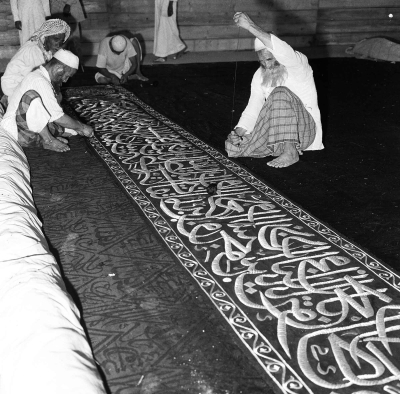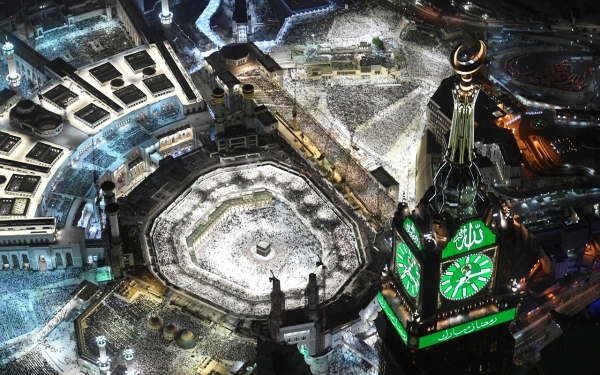
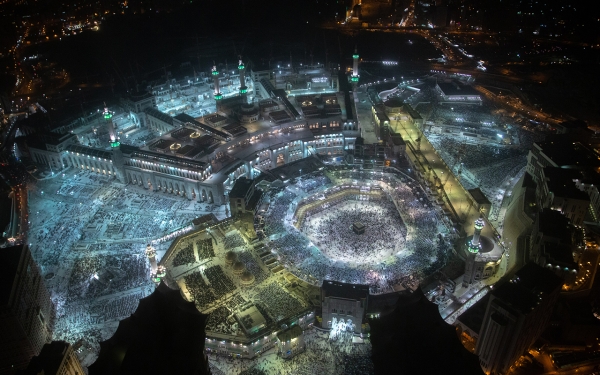
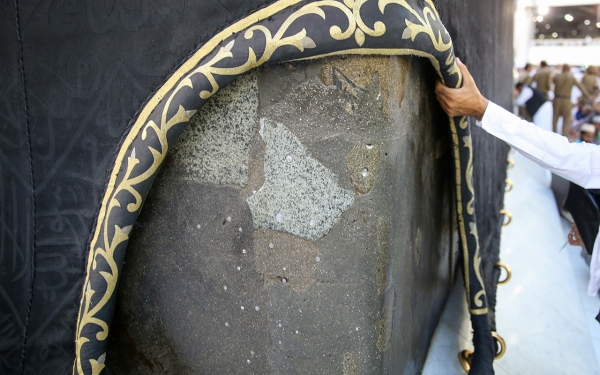
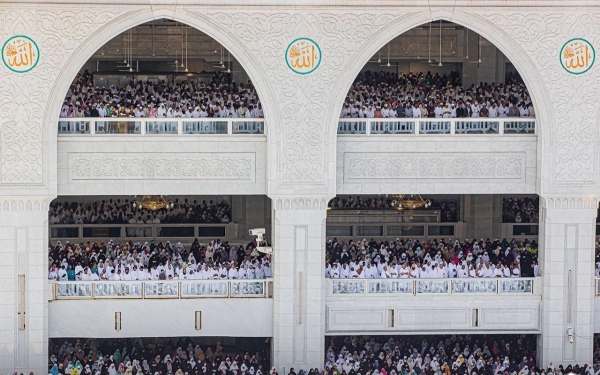
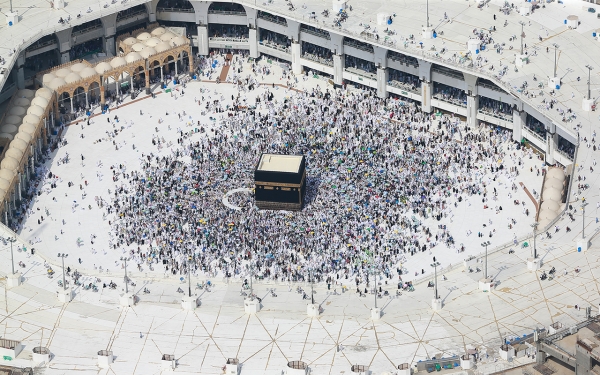
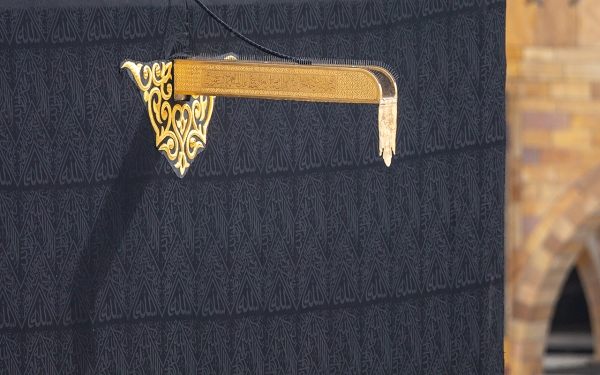
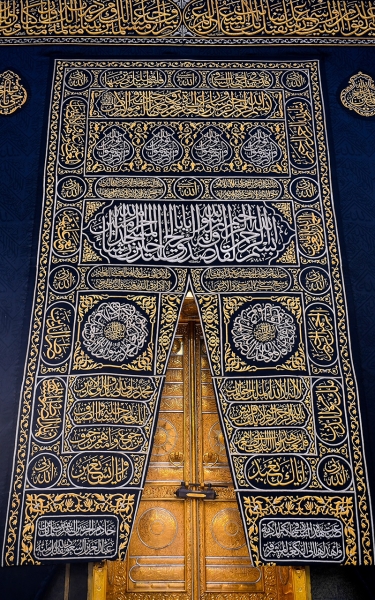
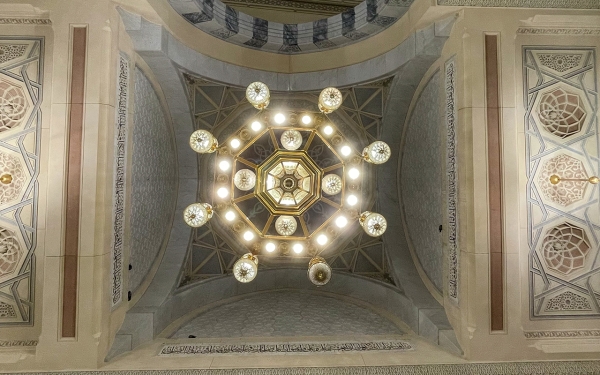
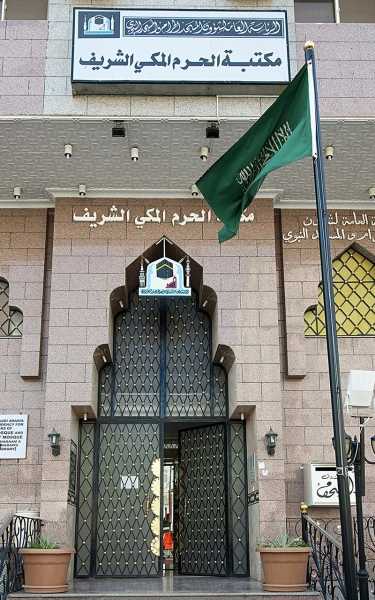
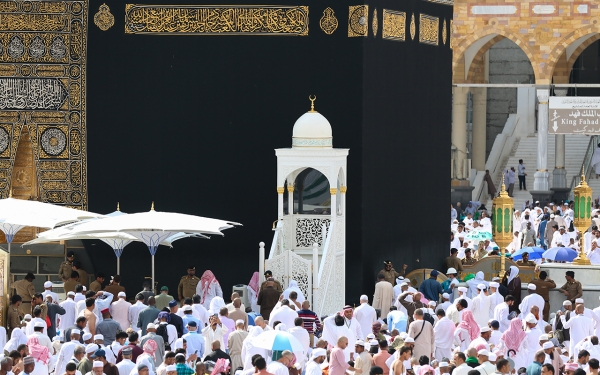
The Grand Mosque is the mosque that houses al-Kaaba al-Musharrafa, the Qibla for Muslims. It is the holiest site on earth for them, as they orient themselves towards it and face it during prayer, regardless of where they are. It derives its name, Masjid al-Haram, from the prohibition of combat within its grounds. Located in Makkah al-Mukarramah, it is directly overseen by the General Presidency for the Affairs of the Grand Mosque and the Prophet's Mosque. It is the oldest mosque in the world and the largest in terms of area and capacity, with a total area of approximately 1.5 million m and a capacity estimated at three million worshipers, as well as 107,000 worshipers performing Tawaf (circumambulation) per hour.
Importance of the Grand Mosque
Visiting the Grand Mosque, for those who are able, is one of the pillars of Islam, given its connection to the Hajj and Umrah rites. The reward for praying in it is multiplied by one hundred thousand times compared to other mosques. It also houses several religious landmarks such as Maqam Ibrahim, the Black Stone, and Zamzam Well.
The Grand Mosque location
The Grand Mosque is located in the center of Makkah al-Mukarramah, and the surrounding area is called the central area. It is supervised by the General Presidency for the Affairs of the Grand Mosque and the Prophet's Mosque. It can accommodate about two million worshipers. Throughout Saudi history, it was only closed during the Juhayman terrorist incident, when it was completely closed for two weeks in 1979 to protect the lives of worshipers. Additionally, there was a partial closure imposed due to the COVID-19 pandemic in 2020 to safeguard the health of worshipers and visitors.
Area of the Grand Mosque
The Grand Mosque's total area is approximately 1.5 million m with a capacity estimated at three million worshipers, as well as 107,000 worshipers performing Tawaf (circumambulation) per hour.
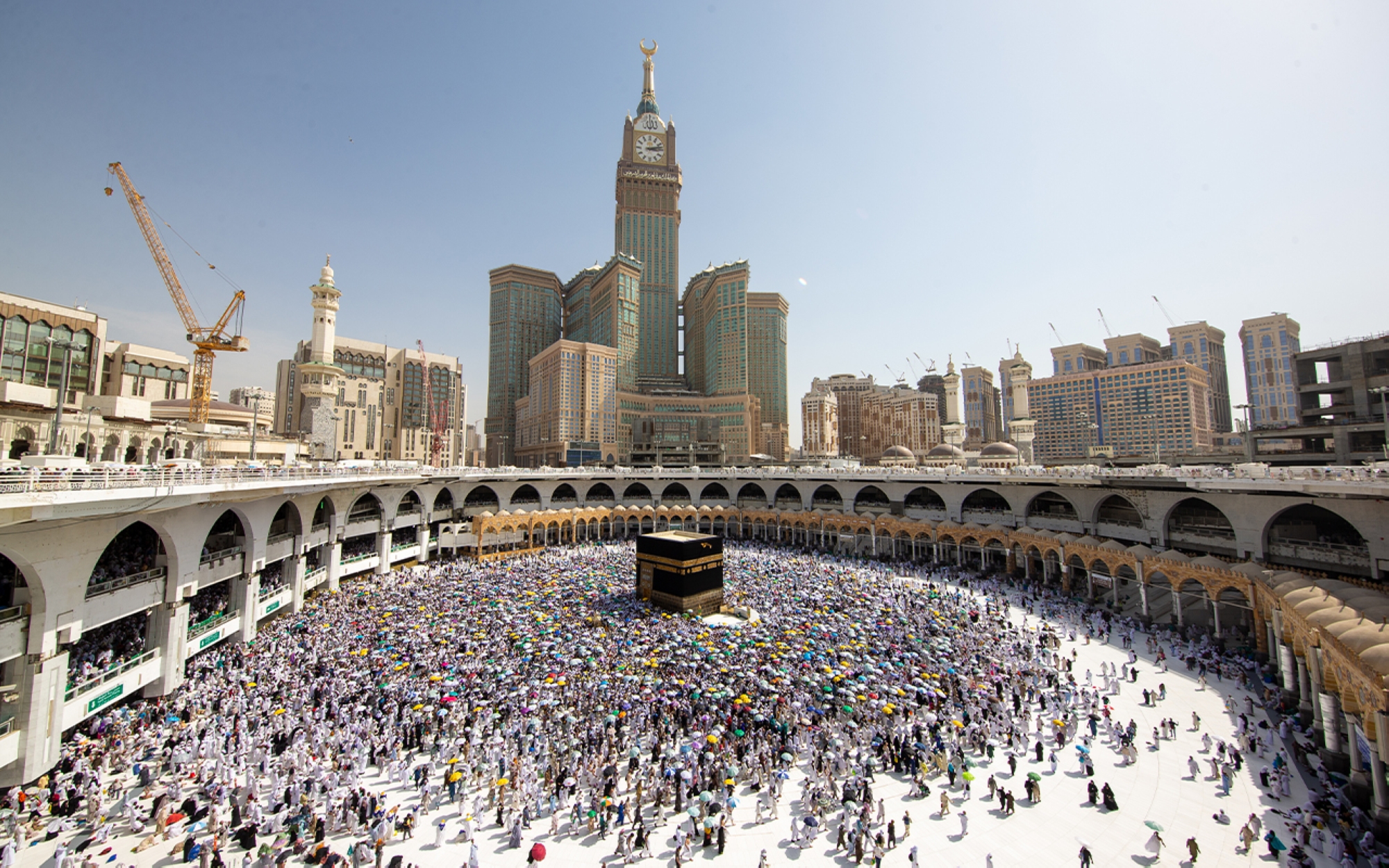
The architecture of the Grand Mosque
The architecture of the Grand Mosque from within includes Sahn al-Mataf, and what surrounds it such as Maqam Ibrahim, the Zamzam well, the minbar (pulpit), the platforms, and the Maqamat. All of these have undergone numerous renovations and modifications.
Mataf
The Mataf is the white marble-paved courtyard surrounding al-Kaaba al-Musharrafa. It is now referred to as the Sahn (courtyard). Muslims perform the Tawaf (circumambulation) around al-Kaaba within the Mataf. It earned special attention and care from the caliphs, kings, and rulers, who worked on its construction and expansion. The first person to pave the Mataf was Abdullah Bin al-Zubair (may Allah be pleased with him) after he built al-Kaaba and completed its construction in 684. He had some stones left over, so he paved around the House with them for about ten arms' lengths. Others followed suit, covering the rest of the Mataf. Walid Bin Abdualmalik covered it with white marble in 709, and it has been repaved and renovated numerous times throughout history.
The Grand Mosque was originally an open courtyard around al-Kaaba for the Tawaf by the pilgrims. During the time of the Prophet Mohammed (PBUH) and Abu Bakr (may Allah be pleased with him), there was no surrounding wall; instead, there were enclosures with doors allowing people to enter from all sides. When Umar Ibn al-Khattab (may Allah be pleased with him) assumed the caliphate and the number of people increased, he expanded the mosque. He bought adjacent enclosures, demolished them, and incorporated them into the mosque. Then, he surrounded it with a short wall, not reaching the height of the mosque's walls. Lamps were placed on it. Umar was the first to make use of the wall for the mosque. Later, during the caliphate of Uthman Ibn Affan (may Allah be pleased with him), he purchased houses in 647 and expanded the sanctuary with them. He built the mosque and the colonnades. Thus, Uthman was the first to add colonnades to the Grand Mosque. After that, pillars and beams were added around the Mataf to hang lighting fixtures. They also served as markers indicating the boundary of the Grand Mosque, which was the case during the time of the Prophet Mohammed (PBUH) and Abu Bakr (may Allah be pleased with him). Anything added beyond that period falls under later expansions.
The new Mataf, after the expansion in 1968, takes the form of a complete circular path with a diameter of 64.8 m, considering the Kaaba as the center. It is surrounded by two adjacent corridors along the circumference of the Mataf, each with a width of 2.5 m. and a height of twenty cm. Thus, the area of Mataf around al-Kaaba is 3,058 m. In the expansion of 1979, the barriers and walkways were removed, and the minbar and the caller's platform were relocated. The opening of Zamzam Well was lowered beneath the Mataf near the outer circle of the Mataf. This expanded the capacity of the Mataf to the limits of the old Grand Mosque, with a diameter of 95.2 m, resulting in a Mataf area of 8,500 m. In 2003, the entrances to Zamzam basement were covered to make maximum use of the Mataf courtyard. This expansion added an area of 400 m to Sahn al-Mataf.
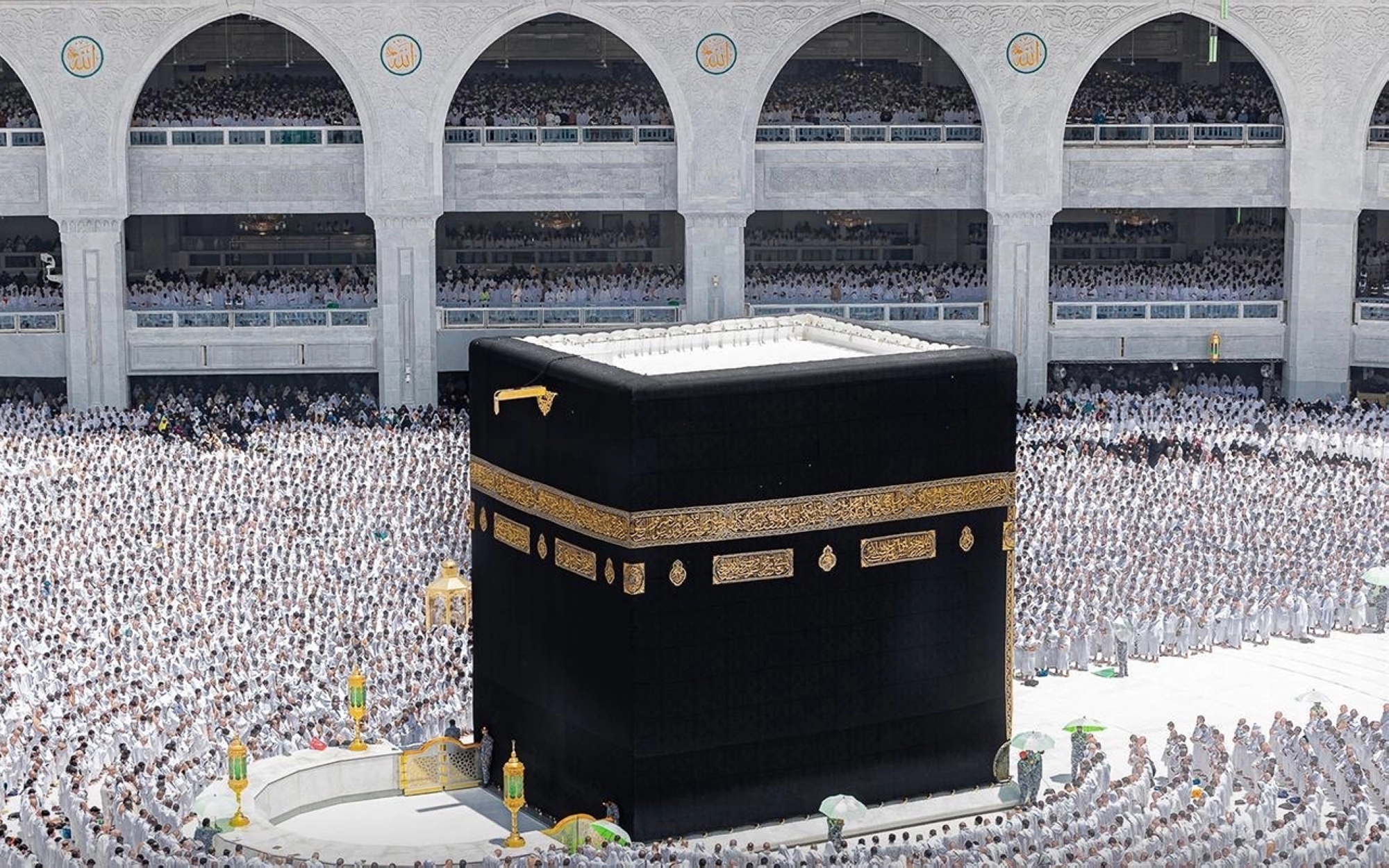
Minbar
Caliphs and governors used to deliver Friday sermons in the Grand Mosque, standing on the ground, facing al-Kaaba and the Black Stone. This practice continued until the year 664. In that year, Muawiyah Ibn Abi Sufyan (may Allah be pleased with him) came from Syria for pilgrimage, and he brought with him a minbar made of wood with three steps. He delivered the sermon in the Grand Mosque, becoming the first to do so from a minbar. The minbar was periodically renewed over time. It continued to be used for sermons until Harun al-Rashid performed Hajj, and his governor of Egypt, Musa Bin Isa, presented him with a splendid nine-step minbar made of finely carved wood as a gift. This became the pulpit of the mosque. The original pulpit was moved to Arafat. Al-Wathiq, the Abbasid caliph, ordered the construction of a minbar for the mosque, as well as others for Mina and Arafat. When al-Muntasir Ibn al-Mutawakkil al-'Abbasi, the Abbasid caliph, performed Hajj during his father's reign, a grand pulpit was erected for him. He delivered a sermon in Makkah, and then led the prayers. Afterward, several more pulpits were added to the mosque. The last of them was the pulpit of Sultan Sulaiman, which he gifted to the Grand Mosque in 1559. This minbar is crafted from luminous, pure white marble. It consists of thirteen steps, with four marble columns on top, and a rectangular dome on top of the columns made of sturdy wood. The surfaces are plated with silver and adorned with radiant gold. This square-shaped dome has retained its lustrous gilding for 388 years and through various eras. The height of this minbar, from the ground of the Mataf courtyard to the crescent of the dome, is approximately twelve m. This minbar possesses a unique quality: the sun's rays do not reach the speaker's spot, neither in winter nor in summer, regardless of the seasons. When the speakers wished to deliver a sermon in the mosque, they would position the minbar against the wall of al-Kaaba, between the Black Stone and the Yemeni Corner. When the speaker wished to give a sermon, he would first touch and kiss the Black Stone, then he would recite a prayer and ascend the minbar. After the sermon, the minbar used to be moved to its place beside Zamzam. When Sultan Sulaiman gifted his mentioned minbar to the Grand Mosque, it remained in its place. The sermons continued to be held on it until the Saudi era. When the expansion of the Mataf became necessary, everything that hindered Tawaf, including the minbar, was removed. It was relocated inside the Ottoman Rowaq (portico), towards the Ajyad side. During the Friday sermon, it was moved beside al-Kaaba. After the Friday sermon concluded, it was returned to its place inside the Ottoman rowaq. This minbar remained in place until 1980, when it was damaged during the Juhayman incident. Some parts of it were preserved and moved to the exhibition of the Two Holy Mosques in Umm al-Joud. Then, a new wooden minbar was constructed during the reign of King Khalid Bin Abdulaziz to replace the one that had broken. It continued to be used for sermons until a new design for a remote-controlled minbar was implemented. This minbar combines the authenticity represented by Islamic decorations with advanced technology. After it was used, some observations were noted, adjustments were made, and it was received and put into operation on the first Friday of the blessed month of Ramadan 2002.
The Four Maqamat (Shrines)
They are found in the Grand Mosque and are dedicated to the four Imams: Abu Hanifa, Shafi'i, Ahmad Ibn Hanbal, and Malik. These shrines are shaded areas with roofs supported by columns, each containing a mihrab. The respective Imam of each school of thought leads the prayer in their designated shrine. All four of these mentioned shrines are located behind the Mataf and behind Zamzam well. The exact date of the construction of these shrines is unknown, but it is likely that they were established between the years 940 and 1095.
The four shrines remained in place until royal approval was issued by King Abdulaziz Al Saud for the expansion of the Mataf. The four shrines were demolished in 1958. The Hanbali shrine was demolished first, followed by the Maliki, then the Hanafi, and finally the Shafi'i. The demolition of the Shafi'i shrine was delayed because it does not have a separate independent structure like the other shrines. It is located above Zamzam Well building, so its demolition was delayed until the construction of the Zamzam Well building was completed in 1963.
Lamps and Lanterns
It is mentioned that the first to provide light for the people of Tawaf and the people of the Grand Mosque was Uqbah Bin al-Azraq Bin Amr al-Ghassani. He used to place a great lamp on the edge of his house, providing light to the people of Tawaf and the people of the mosque. His house was adjacent to the mosque, which, at that time, was narrow, surrounded by houses but without walls. During the reign of Abdualmalik Bin Marwan, Zamzam lamp was placed near the black stone. Umar Bin Abdulaziz used to instruct the people on the night of the sighting of the crescent of Muharram to light fires in the surroundings of Makkah and to hang lamps for the pilgrims, fearing theft. during the caliphate of al-Ma'mun in 831/832, a tall column was placed opposite the Zamzam lamp at the corner of the western side. When Mohammed Bin Dawud became the ruler of Makkah, he installed two tall columns, one near the Yemeni corner, and the other near the Levant corner. when Harun al-Wathiq bi-llah took over, he ordered the construction of columns that were almost ten arms-length tall. these were placed around the Tawaf area for the convenience of the Tawaf performers. he also ordered the installation of eight large chandeliers for lighting, two of which were hung in each direction of the grand mosque. it is mentioned that the first person to light lamps in the Grand Mosque in the area of the lamps was Mohammed Bin Ahmad al-Mansouri. He set up wooden pillars in the middle of the mosque and hung ropes between them. Lanterns were placed on them for illumination, and this practice continued with the princes, caliphs, and sultans placing Zamzam lamps during the seasons and throughout the year.
Bani Shaybah Gate
It is the existing arch near the Shrine of Ibrahim (PBUH), opposite the door of al-Kaaba. It was originally known as the Bab al-Salam (Door of Peace) before the expansion of the Grand Mosque. It is attributed to the Bani Shaybah because it was located next to the residence of Shaybah Bin Uthman al-Hajbi, a leader of al-Kaaba. This gate, along with other barriers, was removed during the expansion of the Mataf in the second phase of the first Saudi expansion, which took place between 1962 and 1969.
The Line Pointing to the Black Stone
There used to be a circle in Sahn al-Mataf, within which there were markings for the Black Stone and the Yemeni Corner. This circle has been removed, and in its place, a line indicating the Black Stone has been drawn, right at its location. Markers indicating the start and end of the circumambulation were also added. Later, studies showed that the crowd tends to congest and stumble at this line. It was deemed beneficial to remove it. Indeed, its removal brought much ease to the circumambulating pilgrims around al-Kaaba, reducing congestion at the Black Stone.
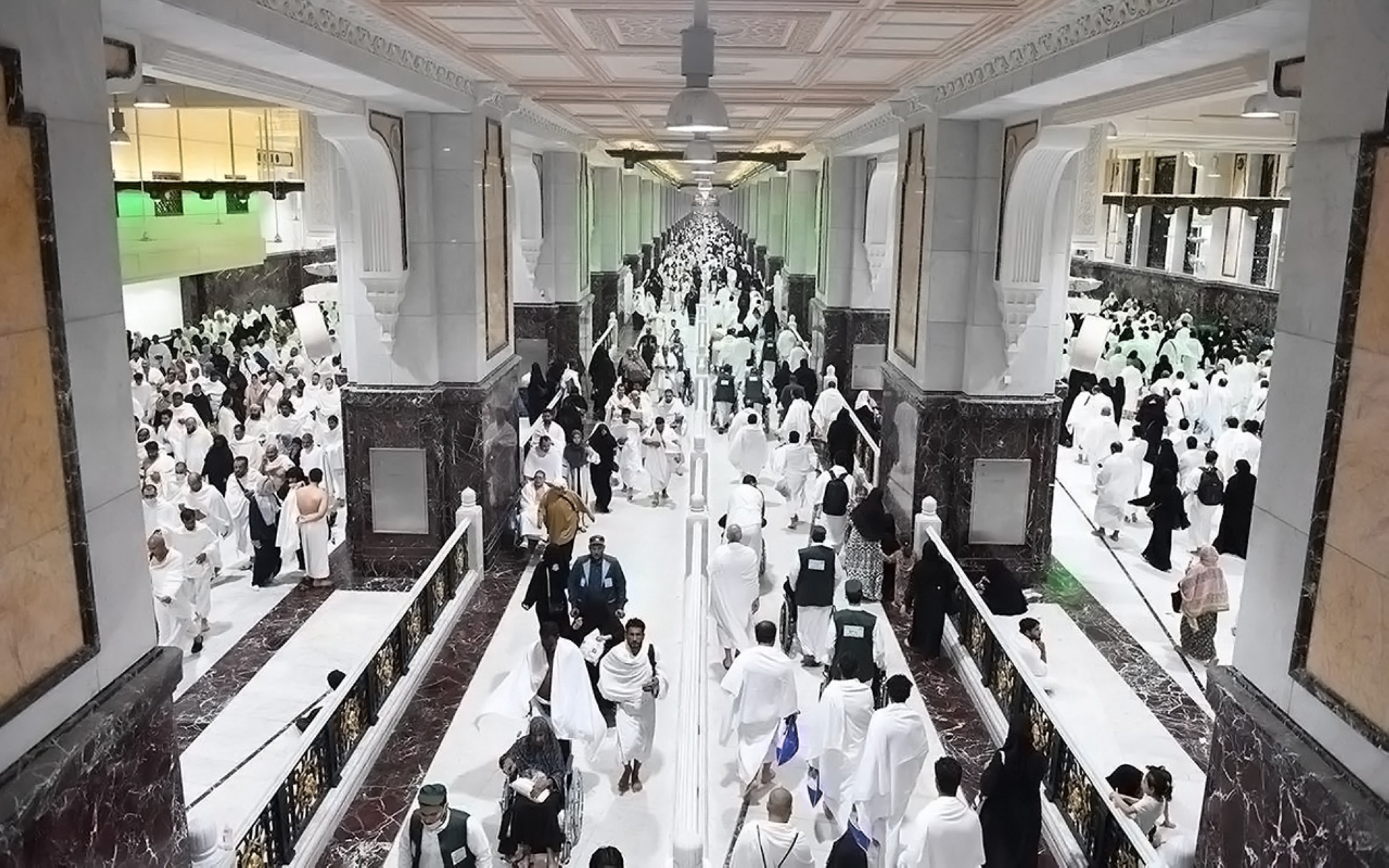
Masa'a
It is a road or street east of the Grand Mosque, bordered by Safa to the south and Marwa to the north. Safa and Marwa are two mountains between the plain of Makkah and the mosque. Muslims are ordered to perform the Saee between Safa and Marwa seven times when performing the Hajj or Umrah, starting from Safa. From Safa to Marwa is one round, and from Marwa to Safa is another round, and so on, seven rounds ending at Marwa.
The Masa'a remained an open space for thirteen and a half centuries. The person who wanted to perform the Saee would climb to Safa until he could see al-Kaaba, face the Qibla, and pray to Allah Almighty. Then he would go to Marwa, and on his way, a little after Safa, he would find a valley. He would then put his feet in the valley and run until he had crossed it. He would then continue his Saee to Marwa. When he reached Marwa, he would climb it until he could see al-Kaaba, and pray to Allah Almighty. this continued until the caliphate of Abu Ja'far al-Mansur, when his governor in Makkah, Abdulsamad Ibn Ali Ibn Abdullah Ibn Abbas, built twelve steps on Safa and fifteen steps on Marwa to make it easier to climb them. These steps have been renovated and repaired more than once throughout history. In 1923, during the reign of Sharif Hussein, a canopy was built over Masa'a street to protect pilgrims from the heat of the midday sun. This was the first time that the Masa'a had ever had a roof (canopy). As for the floor of the Masa'a, the first repair and leveling of it were in the time of al-Mahdi, who made a large expansion of the Grand Mosque from all sides. Part of the Masa'a was included in this expansion, so the floor of the Masa'a was leveled, and some of the depressions were filled with dirt and stones left over from this construction. The rulers continued to repair the floor of the Masa'a whenever there was an opportunity to do so, until King Abdulaziz Al Saud came to power. He ordered the Masa'a to be paved with square stones in 1926. This was the first time that the Masa'a had been paved with stones. Before that, it was dirt that would kick up dust. The canopies of the Masa'a were also renovated by King Abdulaziz in 1949. The width of the entire roof was twenty and a half m. Before the Saudi expansion that was completed in 1956, this canopy was dismantled and then reassembled. It remained until 2001, when it was completely removed.
After King Abdulaziz saw the severe overcrowding of the worshipers and pilgrims who were increasing in number year after year, he ordered that studies be conducted and designs be drawn up for the expansion of the Grand Mosque. The first designs for the expansion of the Grand Mosque were started in early 1956, after King Abdulaziz's death, during the reign of King Saud, who was determined to carry out his father's, King Abdulaziz's, orders to expand the Grand Mosque, starting with the construction of the masa'a. In 1957, a crack appeared in the arch at Marwa. Fearing that it would fall on Saee performers, it was decided to demolish it. The building on Safa was also demolished in 1958. Then, between 1958 and 1962, a new staircase was built on Safa and another on Marwa for ascending and descending, but it was later replaced with a marble slide.
The Masa'a is now considered the longest aisle of its kind in the world. It is a two-story building, 394 m long and twenty m wide. It was built with reinforced concrete in the form of a building with a concrete structure. This structure was founded in a longitudinal section on a compact sandy layer of the valley, and the sections of this structure near the Safa and Marwa hills are founded on igneous rock. The height of the Masa'a is 11.75 m, and it has a total of sixteen doors. There are eleven doors on the eastern side facing Qushashiyah Street, and the remaining five are on the western side after Bab al-Salam. On both sides, there are barriers that create a double passage for the passage of wheelchairs used by elderly and sick saee performers. The Masa'a is equipped with 228 windows on its sides for ventilation. Additionally, it is equipped with desert air conditioning systems and fans to moderate the atmosphere inside the Masa'a. Marble was used to pave the floors, and it covered the walls up to the level of the windows. In the Masa'a, there are sixty-four arches (portal frames) that are five m apart from each other. The columns supporting them are covered with marble and artificial stone. The slopes of Safa and Marwa were paved with divided marble to prevent pilgrims from slipping during Saee. A dome was erected over Safa. The surface of Marwa was made in the shape of a pyramid and covered with green semi-circular tiles. Adding an upper floor to the ground floor was a necessary idea to accommodate the constant increase in the number of pilgrims. The first floor, like the ground floor, is 394 m long and twenty m wide. Its height is 8.5 m. To allow saee performers on the first floor to see Safa and Marwa, circular and rectangular balconies were added at the ends, respectively. Each of them has stairs with platforms leading to the Masa'a. A bridge was constructed at the end of Masa'a at Marwa, connecting it to al-Qarara Street in the north. The total area of both floors is 16,700 m.
Zamzam Well
It is located east of al-Kaaba al-Musharrafa in Sahn al-Mataf, adjacent to the Multazam. It is an ancient well dating back to the time of Ismail (PBUH). Zamzam water is the name of this well, and some of its other names are: Zamzam, Maktooma, Madnoona, Shubaa, Suqya al-Rawa, Rakadat Jibreel, Hazmatu Jibreel, Shifa Suqam, Taam Tu'am, Hafirat Abdul-Muttalib. These names are related to its qualities and the origin of its placement. Modern studies have concluded that the Zamzam Well receives its water from ancient bedrock through three rock fractures that extend to under al-Kaaba al-Musharrafa, from the side of Safa, and to the side of Marwa. The water converges in the well. The well is currently crooked and tilted towards the direction of al-Kaaba to the extent that the opening of the well cannot be seen from its bottom. The wall of the well is lined from the inside to a depth of 14.80 m, from the opening of the well. Below this depth, there are two openings to feed the well: one facing the direction of al-Kaaba al-Musharrafa, and the other to Ajyad. Then comes a carved part in the mountain to a depth of 17.20 cm. These differences in measurement are very small, and this is due to the fact that the well is now below the surface of the Mataf, while in the past it was above the surface of the Mataf and thus the measurement was taken from there.
Caliphs, kings, and rulers throughout the ages have paid great attention to the Zamzam well. They built it and made improvements to it befitting its status. The first to use marble in Zamzam and on the grille and to pave its floor with marble was Abu Ja'far al-Mansur. After him, repairs and improvements continued until the Saudi era, when King Abdulaziz ordered the installation of a pump-to-pump Zamzam water to two upper zinc tanks. Each tank was connected to twelve taps distributed around the well, where buckets were used to extract Zamzam water from the well. Then, the buildings built on the well were removed. In 1962, King Saud issued a Supreme Order to expand the Mataf. The opening of the well was lowered below the Mataf in a basement with a depth of 2.7 m. It is accessed by a staircase that is divided into two sections: one for men and the other for women. This marked the end of the bucket stage, which was replaced by taps in 1963. In 1979, King Khalid ordered the cleaning of Zamzam Well using the latest methods and by experienced divers. This work was one of the greatest cleaning works in the history of Zamzam Well. As a result, the well overflowed with Allah's blessing with much more water than it was before. During the reign of King Fahd, studies on the Grand Mosque deemed it necessary to cover the entrances to the Zamzam basement in order to maximize the use of the Mataf courtyard, which is crowded with pilgrims during busy periods. To facilitate them and protect their safety; this was done by roofing the entrances to the basement leading to the well, and moving the drinking fountains to the side of the Mataf courtyard. These works increased the Mataf courtyard by 400 m, which led to accommodating the largest number of worshipers, and facilitated the movement of circumambulation around al-Kaaba. The drinking fountains were placed in two sections (men and women) under the new arcades that were built as part of the project to expand the Mataf in the Grand Mosque.
It is noteworthy that Zamzam Water is now available throughout the Grand Mosque through the well itself, through containers distributed evenly throughout the mosque, numbering up to more than 27,000 containers, which increase during seasons. In addition to more than 550 drinking fountains spread throughout the mosque and surrounding squares, the number of taps has reached 3,000 taps. In addition to Zamzam complexes outside the mosque to fill the bags, and filling stations in the Kady area. The well pumps between eleven and eighteen and a half l per second. Zamzam Water is cooled by the cooling station located opposite Bab al-Fath, which was established in 1984. King Abdullah Project for Zamzam Water Distribution that was founded in 2010 in Kady area is considered a significant leap in the services of Zamzam water and in meeting the increased demand for it. The project has provided services for over eighteen million beneficiaries since its inauguration. The Zamzam Water Supply Administration at the Grand Mosque has been responsible for overseeing the Zamzam Well and providing chilled and regular Zamzam water in containers since its establishment in 1980. It works to clean them and provide them with the necessary plastic cups. It also cleans and washes drinking fountains and metal cups, and monitors the temperature of the drinking fountains. In order to ensure the cleanliness of Zamzam Water and the absence of pollutants, the General Presidency for the Affairs of the Grand Mosque and the Prophet's Mosque (formerly) provided a laboratory for the analysis of Zamzam Water. This laboratory supervises all stages of sterilizing Zamzam Water, as well as monitoring the filling of tanker trucks carrying Zamzam Water allocated to the Prophet's Mosque. The Prophet's Mosque is supplied with Zamzam Water around the clock from the filling stations in Kady. Zamzam Water is sterilized with ultraviolet rays without adding any chemicals. The sterilization rate from bacteria and viruses reaches 99.77 percent. One KW of electricity sterilizes 12,000 gallons of water. One of the advantages of this sterilization method is to ensure that the color, taste, and smell of Zamzam Water do not change. Zamzam Water undergoes a number of health and preventive measures, starting from the pump of water from Zamzam well in a closed circle through filters that block dirt and impurities, and through stainless steel pipes.
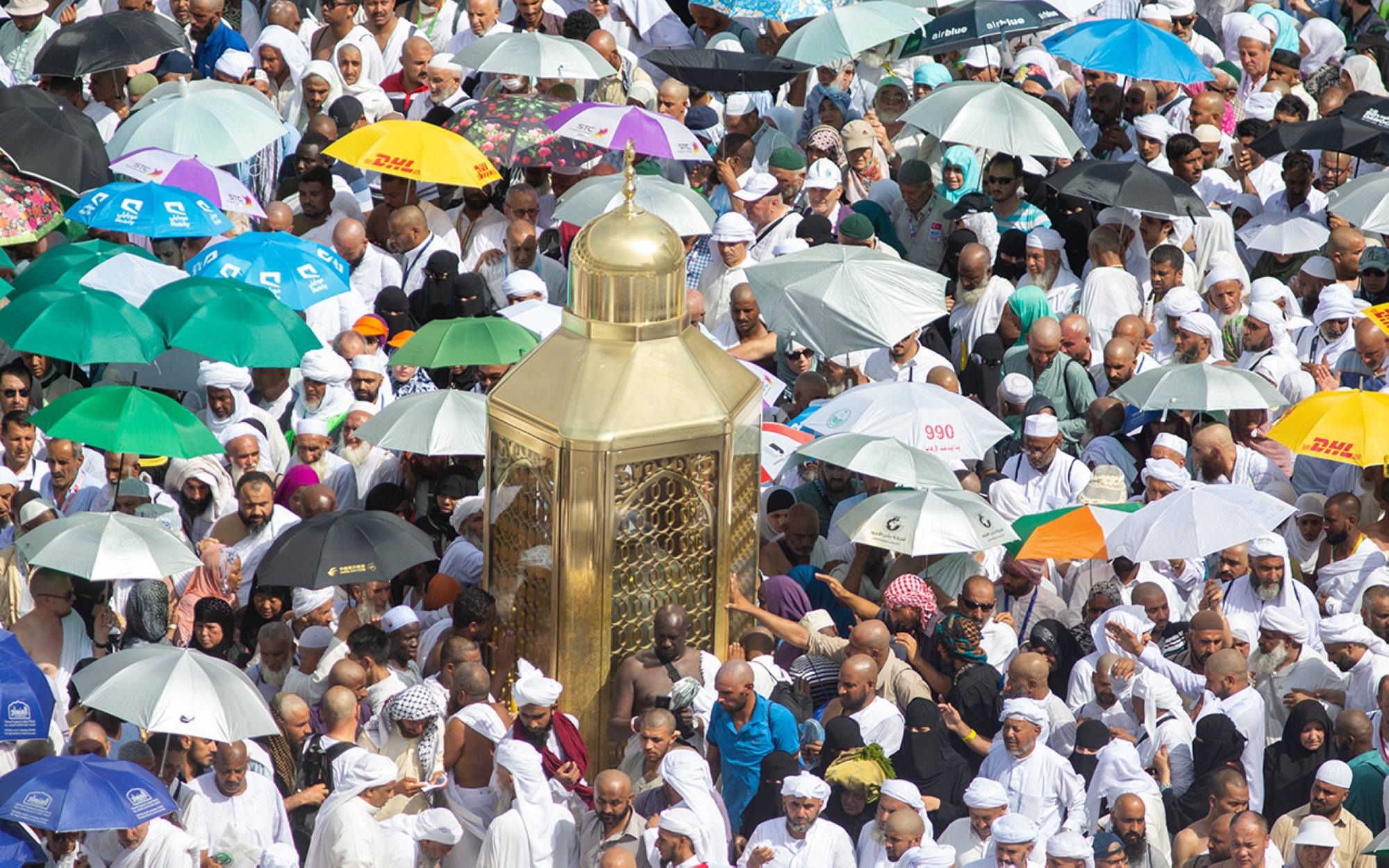
Maqam Ibrahim (Shrine of Ibrahim)
It is the historical stone on which Prophet Ibrahim (PBUH) stood when building al-Kaaba al-Musharrafa. It holds significance as Allah commanded Muslims to take it as a place of prayer during Hajj and Umrah. The historian Basalamah described it as a soft stone of the type of water stone, and it was not flint, and it is a square stone, with dimensions of about fifty cm in length, width, and height, equivalent to an arm's length. In its center, there are two oval-shaped rectangular imprints believed to be the footprints of Prophet Ibrahim (PBUH). These impressions were made by people wetting their hands and placing Zamzam Water in them several times, resulting in the replacement of the original imprints. Maqam Ibrahim initially adjoined the wall of al-Kaaba itself. However, during the caliphate of Umar Ibn al-Khattab (may Allah be pleased with him), it was moved away from al-Kaaba's wall. It remained a subject of attention for caliphs and kings. The first to decorate it was Caliph al-Mahdi in the year 777, who ordered it to be plated with gold. It underwent several renovations over the centuries. In 1967, during the reign of King Faisal, it was moved further back to accommodate the increasing number of pilgrims, following the approval of the Constituent Council of the Muslim World League. The existing structure was demolished, and a transparent crystal dome was placed over the Maqam. This allowed for a clear view of the Maqam and the footprints of Prophet Ibrahim (PBUH). A gilded metal network was installed on top, with a small dome and crescent at its pinnacle, all mounted on an oval-shaped reinforced concrete base covered with black granite. It was renovated again during the reign of King Fahd Bin Abdulaziz in 1996. The metal structure was replaced with a high-quality brass one, and a gold-plated inner grid was added. The concrete base, originally made of black granite, was replaced with local Karara white marble adorned with green granite, resembling the appearance of the original Hijr marble. This transformation gave the Maqam an organic, flowing shape, departing from its previous polygonal form.
Al-Kaaba al-Musharrafa in the Grand Mosque
Building al-Kaaba al-Musharrafa
Al-Kaaba al-Musharrafa is the first House built for humanity, as stated in the verse: (Indeed, the first House established for mankind was that at Bakkah blessed and a guidance for the worlds). Historians have debated who initially built it, but the prevailing view is that it was constructed before the time of Prophet Adam (PBUH). It is believed that angels were the first builders of al-Kaaba, and it was erected beneath the celestial throne, after the House in the heavens (al-Bayt al-Ma'mur). Al-Kaaba, a majestic structure situated in the center of the Grand Mosque, serves as the focal point and center of attention for Muslims. Over the ages, various peoples, including Amalek, Jurhum, Khazraj, Quraysh, and others, have taken turns residing in its vicinity. Al-Kaaba held a position of great reverence for them, and serving it was a source of pride and honor. When Islam came, it elevated the sanctity of al-Kaaba even further, emphasizing the importance of honoring and venerating it. Al-Kaaba has been rebuilt several times throughout history. One example is that the Quraysh rebuilt al-Kaaba and left part of it attached to the Black Stone, as their funds were limited. The Prophet (PBUH) wanted to rebuild it on the foundations of Ibrahim (PBUH), by including the part they left outside, and by making it have two doors that are attached to the ground. However, this was not realized until the year 684, when Abdullah Ibn al-Zubayr was the governor of Hijaz. He built al-Kaaba as the Prophet (PBUH) wanted. In 693, Caliph Abdualmalik Bin Marwan ordered al-Kaaba to be rebuilt on the original construction that Quraysh had built. It remained in this condition until 1631, when floods destroyed the northern wall of al-Kaaba and parts of the eastern and western walls. The scholars agreed to demolish the remaining walls, and Sultan Murad Khan ordered the demolition and reconstruction. After that, al-Kaaba did not need to be demolished, but only repairs and renovations. Until the reign of King Fahd Bin Abdulaziz, some damage was observed in some parts of al-Kaaba, including the wood, the roof, and some wooden pillars. He ordered its complete renovation from the inside and outside in 1996.
Historians have differed in determining the dimensions of the Kaaba, and the source of this variance lies in the difference in measurements. The difference between one arm's length and another can lead to discrepancies, and these measurements have varied. The latest measurements, conducted by the Hajj Research Center at Umm al-Qura University, are as follows: from the Black Corner to the Levant Corner is 11.68 m, which includes the door of al-Kaaba. From the Yemeni Corner to the Western Corner is 12.04 m. From the Black Stone Corner to the Yemeni Corner is 10.18 m, and from the Levant Corner to the Western Corner is 9.90 m.
Names of al-Kaaba al-Musharrafa
Al-Kaaba al-Musharrafa has been known by many names, each of which reflects its honorable status. One of its names is Kaaba because of its cubic shape. It's also referred to as Bakka because it causes the necks of tyrants to lower in awe. However, there are differing opinions on this. It's called al-Bait al-Haram (the Sacred House) as mentioned in the verse: Allah has made the Kaaba, the Sacred House, standing for the people. It's also known as al-Bait al-Atiq (the Ancient House). There's some disagreement about the exact meaning of al-Bait al-Atiq. Some say it's because Allah freed it from the hands of tyrants, and no oppressor ever gained power over it, or because no mighty oppressor could ever overpower it. However, there are other opinions as well. Another name for it is al-Banea, and it used to be called Banea Ibrahim (the Structure of Ibrahim) because he built it. People used to swear a lot in the God of this Banea. It is also known as al-Dawwar (the Rotating). Another name is al-Masjid al-Haram (the Sacred Mosque), as mentioned in the verse: 'So turn your face towards al-Masjid al-Haram.' This refers to al-Kaaba. Other names include Qadis, Nadir, and al-Qaryah al-Qadimah (the Ancient City).
Description of al-Kaaba al-Musharrafa from inside
Al-Kaaba al-Musharrafa from the inside is a solid rectangular structure with no windows. Inside it are three pillars that support the roof of al-Kaaba. They are made of the strongest types of wood, and they are brown in color with a slight inclination to black. The circumference of each pillar is approximately 150 cm, with a diameter of forty-four cm. Each pillar has a square wooden base carved with wood carving, in addition to three hoops for reinforcement. The pillars rise to the first ceiling that follows al-Kaaba al-Musharrafa and do not pass through this ceiling to the upper ceiling that face the sky. However, several pieces of wood were placed on top of each other on the heads of these three pillars from inside the two ceilings until they reached the upper ceiling. In this way, these pillars are the bearers of the two ceilings. This was placed by Abdullah Ibn al-Zubayr (may Allah be pleased with him) in 684.
The length of the wall with its door is 225 cm. On the right of the entrance to al-Kaaba (in the Levant corner) is the staircase leading to the roof. At the end of it, before reaching the roof, there are two small doors, each of which leads to the space between the two ceilings of al-Kaaba. The distance between the two ceilings is 120 cm. The staircase ends at the roof with a skylight covered with a tight cover to prevent rain from entering. It is lifted up when going up to the roof. The floor of al-Kaaba is covered with colored marble, with white predominating. The walls are also covered with colored marble with small carvings. On the walls and ceiling is a curtain of pink silk embroidered with the Shahada and some of the holy names of Allah in white. Inside al-Kaaba, there are nine marble stones, written in the Thuluth script by carving into the stone, except for one stone, which is written in the Kufic script. The letters of the words on this plaque are made up of pieces of precious colored marble, glued together on the base of the square Kufic script. All of these stones were written after the twelfth century. The document of the Custodian of the Two Holy Mosques, King Fahd Bin Abdulaziz, was also placed, engraved on a marble plaque in the eastern wall between the door of al-Kaaba and the door of repentance; it refers to the date of the comprehensive renovation of the construction of al-Kaaba al-Musharrafa. Thus, the number of inscribed stones in the interior of al-Kaaba al-Musharrafa has become ten stones, all of them made of white marble. All of these marbles are raised from the marble floor of al-Kaaba by 144 cm, except for the stone placed above the arch of the door of al-Kaaba al-Musharrafa from the inside, which rises by more than two m.
Kaaba opening occasions
For its internal washing: Al-Kaaba is washed from the inside once a year in the fifteen of the month of Muharram. This task is carried out under the supervision of the Custodian of the Two Holy Mosques or his representative. Also present are the General President for the Affairs of the Grand Mosque and the Prophet's Mosque, his deputy for the Affairs of the Grand Mosque, along with a number of ambassadors from Islamic countries, heads of Hajj missions, and other high-ranking officials.
Opening it for some leaders: Some leaders of Islamic countries, along with their senior officials like ministers, come to the Kingdom on official and unofficial missions. They visit the Grand Mosque, either for Hajj or Umrah pilgrimage. They are welcomed by senior officials from the General Presidency for the Affairs of the Grand Mosque and the Prophet's Mosque. Al-Kaaba al-Musharrafa is opened for them as an honor and appreciation for their status, as they represent Muslims in their respective countries. They perform prayers in it, following the example of the Prophet Mohammed (PBUH).
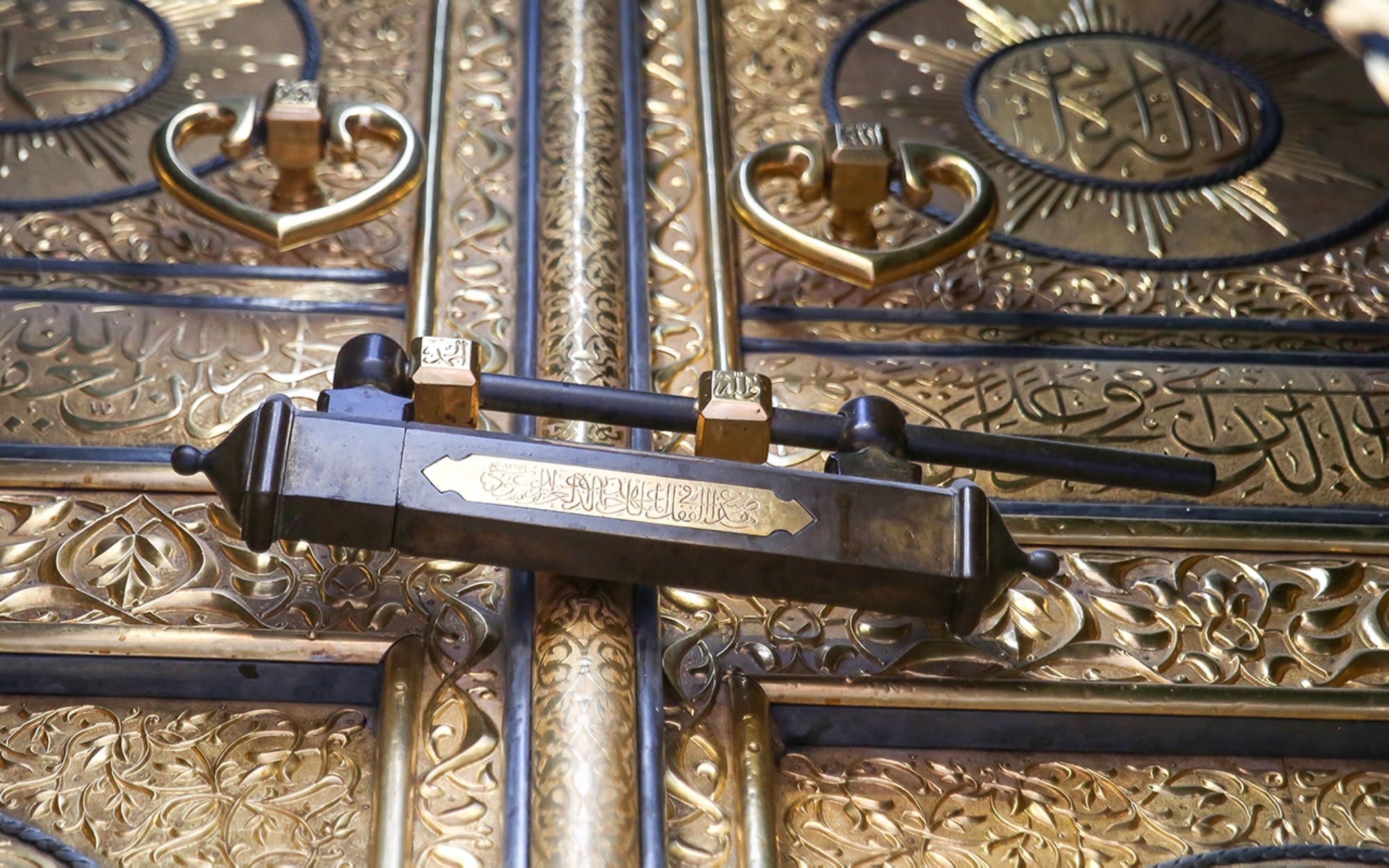
The door of al-Kaaba al-Musharrafa
The door of al-Kaaba is located on its eastern side, 222 cm above the ground from the Shadherwaan. It is 318 cm long, 171 cm wide, and half a m deep. Historians do not agree on who first placed a door on al-Kaaba, but the most likely account is that Tubba'a III, one of the kings of Yemen who lived long before the Prophet's mission, was the first to place a door and key on al-Kaaba. When al-Kaaba was rebuilt by the Quraysh, they made it with two leaves. The doors that have been placed on al-Kaaba over time have differed in their quality, material, and shape. However, the last door was in the Saudi era (and it is the one that is still there today). It was made (along with the door of repentance, which is the door of the ladder leading to the roof of al-Kaaba) by order of King Khalid Bin Abdulaziz from pure gold. The cost of manufacturing the two doors was SAR13,420,000, excluding the amount of gold that was secured by the Saudi Arabian Monetary Agency (currently the Saudi Central Bank). The amount of gold was 280 kg, and it was 99.99 percent pure gold. It took twelve months to make.
The door was made in a special workshop that was established specifically for this purpose. The latest artistic methods were used in its manufacture. As for its decoration, a homogeneous type of decoration was chosen, the most important elements of which are the embossed frame decoration, which is the decoration that continues at the level of the lock location, giving it the necessary importance; because the lock of al-Kaaba al-Musharrafa has a special feature in the traditional and functional shape, as distinctive decorations were added in the upper corners to highlight the shape of an arch surrounding the word of majesty Allah and the name of the Messenger of Allah (PBUH) and the Quranic verses: ('Enter therein in peace and security'), (O my Lord! Let my entry be by the Gate of Truth and Honour, and likewise my exit by the Gate of Truth and Honour; and grant me from Thy Presence an authority to aid me), (Your Lord has decreed upon Himself mercy), (And your Lord said, Call upon Me; I will respond to you.), followed by two fillings in the shape of two shining suns in the middle of which is the word of the two testimonies, in the form of a circular frame, and the door rings were fixed on the floor of the upper fillings, which form a homogeneous unit with the lock in shape and harmony, and the following Quranic verse was written under the upper fillings: (O My servants who have transgressed against themselves [by sinning], do not despair of the mercy of Allah . Indeed, Allah forgives all sins. Indeed, it is He who is the Forgiving, the Merciful). As for the fillings that are under the lock, the Quranic Surah al-Fatiha was written in the middle of them in the form of two protruding discs. The sides were also designed in an artistic way and fixed according to the decorative design, after taking into account the protruding circular plates bearing the names of Allah Almighty, there are fifteen names above the door: O Vast, O Preventer, O Beneficent, on the right side: O Knowing, O All-Knowing, O Forbearing, O Great, O Wise, O Merciful, on the left side: O Rich, O Enricher, O Praised, O Glorious, O Helper.
The door and the key of al-Kaaba al-Musharrafa
The locks and keys of al-Kaaba have multiplied with the multiplication of caliphs, princes, and sultans. The oldest lock found dates back to the eighth or ninth century, and it was made of wood, with inscriptions inlaid with wires of tin and lead. The keys and locks after that were made of iron, and the inscriptions on them were written in gold or silver using the inlay method. The last locks and keys of al-Kaaba were made during the Saudi era by order of King Khalid Bin Abdulaziz, and they are still in existence today. As for the description of the lock, it is long, hexagonal, made of iron, thirty-eight cm long, and three cm wide for each of its six sides, for a total perimeter of eighteen cm. On each of its six sides, there is a thin piece of brass about eight cm long and two cm wide, with a set of verses and phrases engraved in the Thuluth script on each of them. As for the key of this lock, its shape is described as long, resembling the handle of a mortar at its ends. The thickness between them is like the thickness of the little finger (i.e., the ring finger). The length of the key is forty cm, and it may be slightly less than that, by half a cm only. The head of the key is circular, like the groove of a millstone. The diameter of the head circle is three and a half cm, and its thickness is one cm. The head of the key is split into three equal grooves.
Al-Mizab
It is the part that is attached to the roof of al-Kaaba on the north side, extending towards the Hijr. It works to drain the accumulated water on the roof of al-Kaaba when it rains or when the roof is washed, to the Hijr. The first to put a mizab on al-Kaaba was the Quraysh when they built it and made a roof for it. Abdullah Ibn al-Zubair did the same when he rebuilt it, as did the pilgrims during the reign of Abdualmalik Ibn Marwan. However, the first to put gold on it was al-Walid Ibn Abdualmalik. Al-Mizab has changed over the course of history, and the one that exists now is al-Mizab of Sultan Abdulmajid Khan. It was repaired and restored along with the renovation of the roof of al-Kaaba during the reign of King Saud Bin Abdulaziz. It is made of pure silver and is plated with pure gold on all sides. It is in the shape of a rectangle, with the date of its manufacture and renewal written on its sides in the Thuluth script. It was replaced in the comprehensive renovation of al-Kaaba al-Musharrafa during the reign of the Custodian of the Two Holy Mosques King Fahd Bin Abdulaziz with another one with the same specifications. It is 258 cm long, from what is inside the wall of al-Kaaba, twenty-six cm wide, twenty-three cm high on each side, and fifty-eight cm deep in the roof wall.
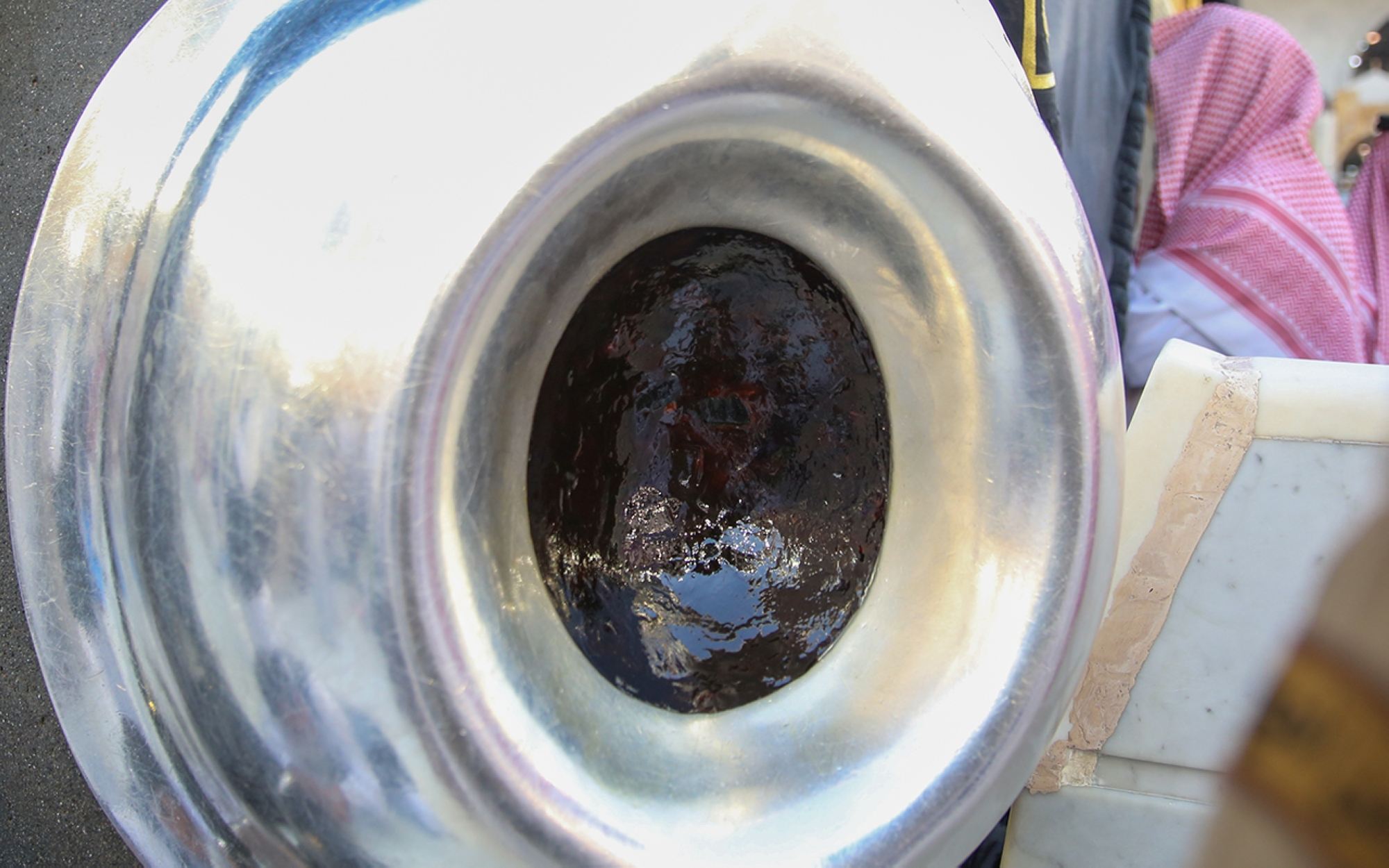
The Black Stone
It is located in the southeastern corner of al-Kaaba from the outside. It is the beginning and end of Tawaf, and it is one and a half m high from the ground. It is black in color and hollow, and it is surrounded by a frame of pure silver to protect it. The place of the stone appears oval, and now it shows eight small pieces of different sizes, the largest of which is the size of a single date. The rest of it is inside the building of al-Kaaba al-Musharrafa. The blackness is on the outside of the stone, but the rest of its body is white. The black stone was placed at its place in al-Kaaba al-Musharrafa after it was built by the Quraysh before the Prophet (PBUH) and remained in its place until the great fire in the incident of the siege of Abdullah Bin al-Zubair (may Allah be pleased with them) where the corner cracked and Ibn Zubair tied it with silver.
Among the virtues mentioned about the Black Stone is that it was brought by Jibreel to Ibrahim (PBUH) from heaven to be placed in its place in the House. Narrated by Ibn Abbas (may Allah be pleased with him): The Messenger of Allah (PBUH) said: The Black Stone descended from paradise, and it was whiter than milk, but the sins of the descendants of Adam made it black. Narrated and edited by al-Tirmidhi, it is reported that Umar (may Allah be pleased with him) approached the Black Stone and kissed it. He said: I know that you are a stone that neither harms nor benefits. Had I not seen the Prophet (PBUH) kiss you, I would not have kissed you, narrated by al-Bukhari.
The Black Stone has been exposed to a number of incidents, the most famous of which was its removal and theft in the Qaramite incident in 929. Its place remained empty for about twenty-two years before it was returned to Makkah and replaced in 950. In 974, a Roman man came from the land of the Romans with a great pickaxe of steel, and he struck the corner with a severe blow until he weakened it. He wanted to hit it again, but a man intercepted him and killed him. In 1023, a man from Egypt came with a sword and a dagger and went to the Black Stone and struck it three times with the dagger. A man caught him and killed him, and a riot broke out between his group and those present in the Grand Mosque. In 1932, a Persian man from Afghanistan came and removed a piece of the Black Stone, a piece of al-Kaaba's cloth, and a piece of silver from al-Kaaba's staircase. The guards of the Grand Mosque caught him and he was punished by death. A team of specialists was tasked with reassembling it, and they made a chemical compound with musk and amber to fix the piece. Then King Abdulaziz took the piece of the Black Stone in his hand and placed it in its place as a good omen, in the presence of the custodians of al-Kaaba and a group of dignitaries. The specialists firmly fixed it.
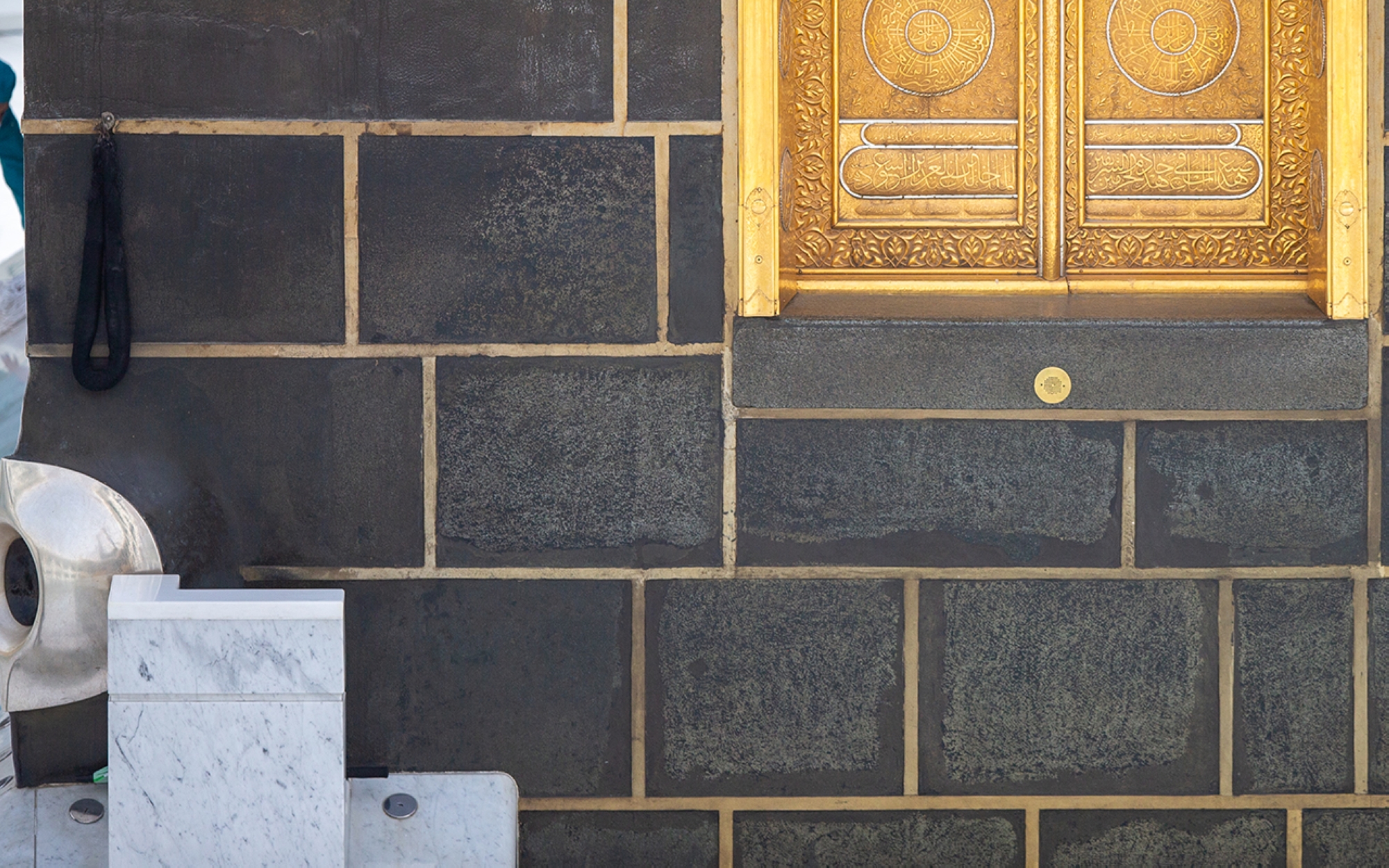
Multazam
The Multazam is the place where people cling to al-Kaaba, located between the Black Stone and the door of al-Kaaba al-Musharrafa. It is called Multazam because people cling to it and supplicate to Allah there. As stated in al-Sahih narrations from the companions (may Allah be pleased with them), the Multazam is the area between the Black Stone and the door of al-Kaaba. It is recommended to put the cheek, spread the hand, and press the face and chest to this place of the House. Shaykh al-Islam Ibn Taymiyyah said: 'If he wishes to come to al-Multazam, which is the area between the Black Stone and the door, and place his chest, face, arms, and palms against it, and supplicate, and ask Allah Almighty for his need, he may do so. He may do so before the farewell Tawaf, for it does not matter if this iltizaam (clinging) is done at the time of the farewell Tawaf or at another time. The companions used to do that when they entered Makkah.'
Al-Hijr
It is the wall located north of al-Kaaba al-Musharrafa in the shape of a semicircle. Its length from the center of the circle from its inner wall to the outer north wall of the Kaaba is eight m. and forty-six and a half cm. It is called al-Hijr because Quraysh, in building it, left from the foundation of Ibrahim (PBUH) due to lack of funds, and walled off the place, so that it would be known that it is part of al-Kaaba. The Messenger of Allah (PBUH) said to Aisha (may Allah be pleased with her): For your people had reduced the area of the Kaaba when they built it. If they had not recently been polytheists, I would build it upon the original. So, if it seems good to your people to build it after me, then come so that I could you show what they left out from it. Then, he showed her about seven cubits. This was narrated by Sahih Muslim. When Abdullah Ibn al-Zubair was the governor of Maakah al-Mukarramah, he rebuilt al-Kaaba according to what the Messenger of Allah (PBUH) wanted. He included in the construction of al-Kaaba what Quraysh had left of the foundations of Ibrahim (PBUH). After Ibn al-Zubair was killed, al-Hajjaj wrote to Abdualmalik Ibn Marwan that Ibn al-Zubair had placed the building on a foundation that was considered by the upright people of Maakah to be flawed. Abdualmalik ordered that what he had built be demolished and that it be returned to the building of the Quraysh.
The first person to marble the Black Stone was Abu Ja'far al-Mansur. Before that, it was built of stones. Its marble has been renewed several times throughout history. It was also renewed twice during the Saudi era, the first time in 1977 when it was renovated to the utmost perfection. Its floor was paved with cold stone brought from Greece, as is the case in the Mataf area. Three metal lanterns were placed on its wall, lit by electricity. In 1996, after the comprehensive restoration of al-Kaaba al-Musharrafa that took place during the reign of King Fahd Bin Abdulaziz, the marble of the walls and floor of the Black Stone was replaced with new marble. The lanterns were returned to their original location. A rope barrier was made for the entrance to the Black Stone, strong in structure and elegant in shape, appropriate to the status of the Black Stone and its greatness. The barrier is opened permanently and is closed only when necessary.
Al-Yemeni Corner
The Yemeni Corner is the southwestern corner of al-Kaaba al-Musharrafa. It is parallel to the southeastern corner, in which the Black Stone is located. It precedes the Black Stone in the Tawaf. It is called the Yemeni Corner because it is facing Yemen. It is distinguished by the fact that it is on the original foundations of the House that were raised by Ibrahim and Ismail, peace be upon them. It is Sunnah for the circumambulator to touch the Yemeni Corner with his hand in every tawaf, but not to kiss it. If he is unable to touch it, he is not allowed to point to it with his hand. He would say between it and the Black Stone, Our Lord! Grant us the good of this world and the Hereafter, and protect us from the torment of the Fire. Some of its virtues are: what was narrated by Ibn Umar (may Allah be pleased with him), saying: The Messenger of Allah (PBUH) said: Wiping the Black Stone and the Yemeni Corner erases sins completely. Narrated by Ahmad on behalf of al-Sahih.
Sadanat al-Kaaba (al-Kaaba Caretaking)
Sudanat al-Kaaba refers to the service, management, opening, and closing of al-Kaaba's door. It is also known as the Hijabah. Those responsible for the affairs of al-Kaaba al-Musharrafa are called al-Suddanah. Initially, the responsibility of Sudanat al-Kaaba was held by Ismail (PBUH), who along with his father Ibrahim (PBUH), was entrusted with raising the foundations of al-Kaaba, and stayed near al-Kaaba to serve it. This sacred duty continued with the descendants of Ismail until it was forcibly taken by their neighbors and maternal uncles, the Jurhum tribe. Later, it passed to the Khuzaah tribe, and then Qusai Ibn Kilab, who was a descendant of Ismail (and the Prophet Mohammed's fourth grandfather) claimed it back. It remained in his family, passing down through his eldest son, Abd al-Dar, and subsequently to the Banu Abd al-Dar, during both pre-Islamic and Islamic periods. Sudanat al-Kaaba remained with his descendants until it was handed over to Uthman Bin Talha. When Makkah was conquered, Prophet Mohammed (PBUH) summoned Uthman Bin Talha and said, Bring me the key. Uthman brought it to the Prophet (PBUH) and handed it to him. The Prophet (PBUH) then opened the door and entered along with Bilal, Usama Ibn Zaid, and Uthman Bin Talha. After exiting, the Prophet (PBUH) returned the key to Uthman Bin Talha and said, Take it, O sons of Abu Talha (referring to Sudanat al-Kaaba), you will be given control of it and only a disbeliever would take it from you unjustly. Uthman passed away without an heir, so it was inherited by his cousin, Shibah Bin Uthman. It remains in the hands of his descendants to this day.
The Grand Mosque's facilities
Al-Haram al-Makki College
It is a college that is concerned with providing distinguished academic religious education in the Grand Mosque, by teaching of a select group of scientific competencies, using modern education technologies, activating institutional partnerships, and community participation, it has five departments: the Department of Sharia, the Department of the Quran and its Sciences, the Department of the Sunnah and its Sciences, the Department of Aqeeda (Creed), and the Department of Arabic Language. The college aims to serve the Grand Mosque by teaching Islamic law, qualifying students of science specialized in Islamic sciences, consolidating the methodology of moderation and balance, and establishing scientific and cultural relations with universities and scientific institutions in the world and documenting them to serve Islam.
Al-Haram al-Makki Institute
An educational institution in the Grand Mosque that was established in 1965, by order of King Faisal Bin Abdulaziz, is concerned with teaching Islamic sciences. It grants its graduates in all stages (intermediate, secondary, and higher) certificates accredited by the Ministry of Education in the Kingdom. It aims to serve the Grand Mosque by studying Islamic law, consolidating the methodology of moderation, facilitating the ways of knowledge, and preparing well-founded students of science and influential scholars.
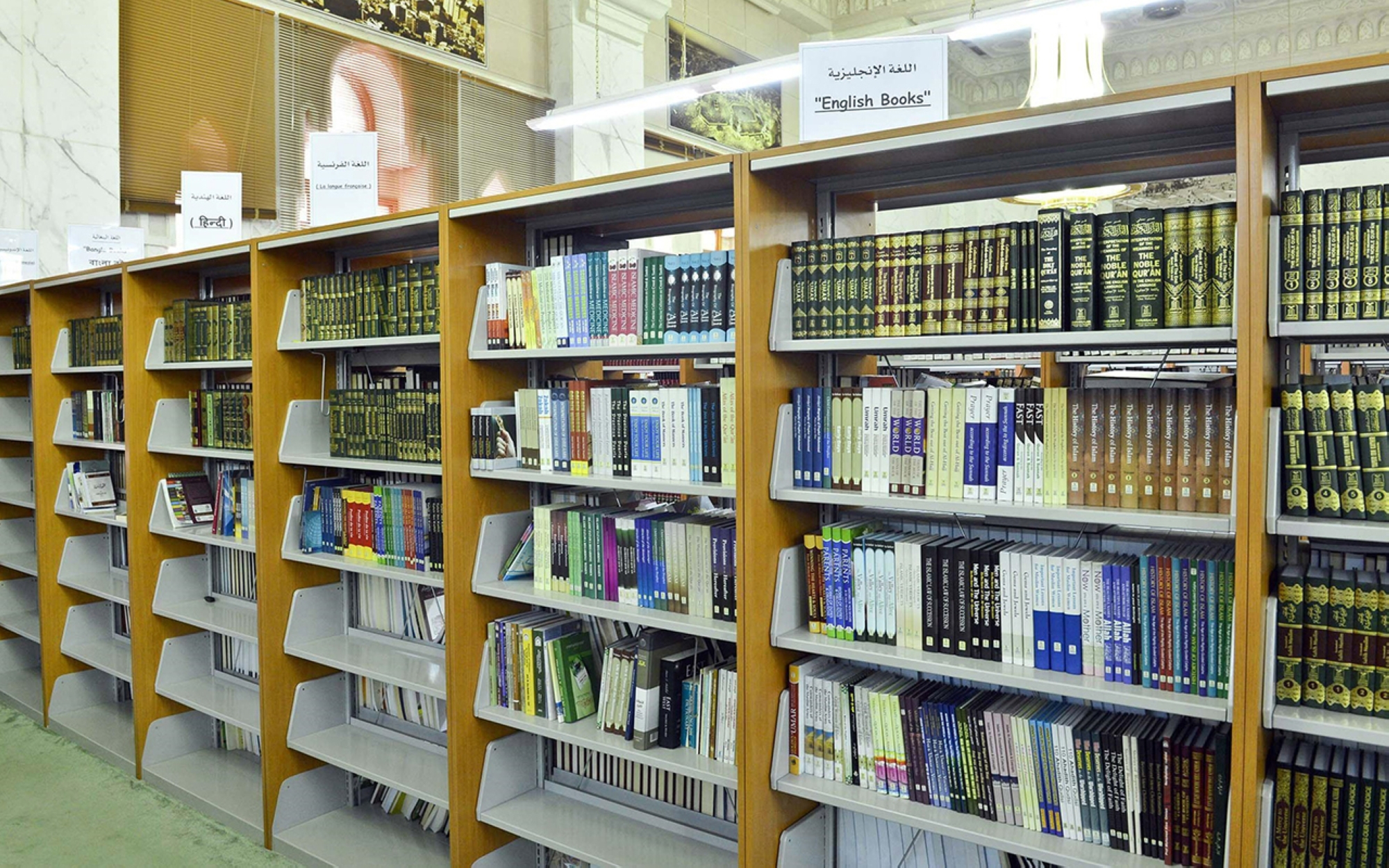
Grand Mosque's Library
It is one of the oldest libraries in the Islamic world, having been established in the eighth century at the beginning of the Abbasid era, approximately in 777. Its name dates back to 1938 when King Abdulaziz Bin Abdulrahman Al Saud ordered the formation of a committee of scholars from Makkah al-Mukarramah to study its conditions. At that time, it was named the Grand Mosque's Library. The library remained affiliated with the Ministry of Hajj and Endowments (now the Ministry of Hajj and Umrah) until 1965 when it was incorporated into the General Presidency for the Affairs of the Grand Mosque and the Prophet's Mosque (now the General Authority for the Care of the Grand Mosque and the Prophet's Mosque) to become a public library that provides its services to students. The library moved to several locations before settling in its current building in Bathah Quraish in Makkah. It encompasses various sections including, the Sheikh Nasser al-Rashid Hall for reading and research, containing over two hundred thousand Arabic books and volumes, and the Sheikh Suleiman Obaid Hall for periodicals and journals, housing approximately 14,899 scientific journals, both old and modern, and around 714 titles. The Manuscripts Section with 7,525 paper manuscripts and over nine hundred thousand digital manuscripts. The Special Libraries Section includes rare and modern informational resources from endowment libraries. The Newspapers Section with about 4,443 old newspapers. The Supply Section serves as the main gateway for the library to provide all its needs. The Gifts and Exchange Section enhances the library's resources by exchanging informational sources with individuals and scientific institutions. The Binding, Sterilization, and Restoration Section deals with damaged books and manuscripts by re-binding them. The Indexing and Classification Section serves as a key to facilitate access to informational resources and meet the needs of beneficiaries. The Imaging Section is responsible for photographing manuscripts and rare books and digitally processing them for preservation to protect them from damage using digital devices and microfilm devices. The Scientific Programs Section focuses on providing programs and scientific activities for the library. The Electronic Section fulfills the needs of beneficiaries by providing electronic informational resources. The Rare Books Section focuses on historical book rarities. The library aims to enhance the scientific and religious mission of the Two Holy Mosques, and spread Islamic culture to visitors of the Grand Mosque from all around the world.
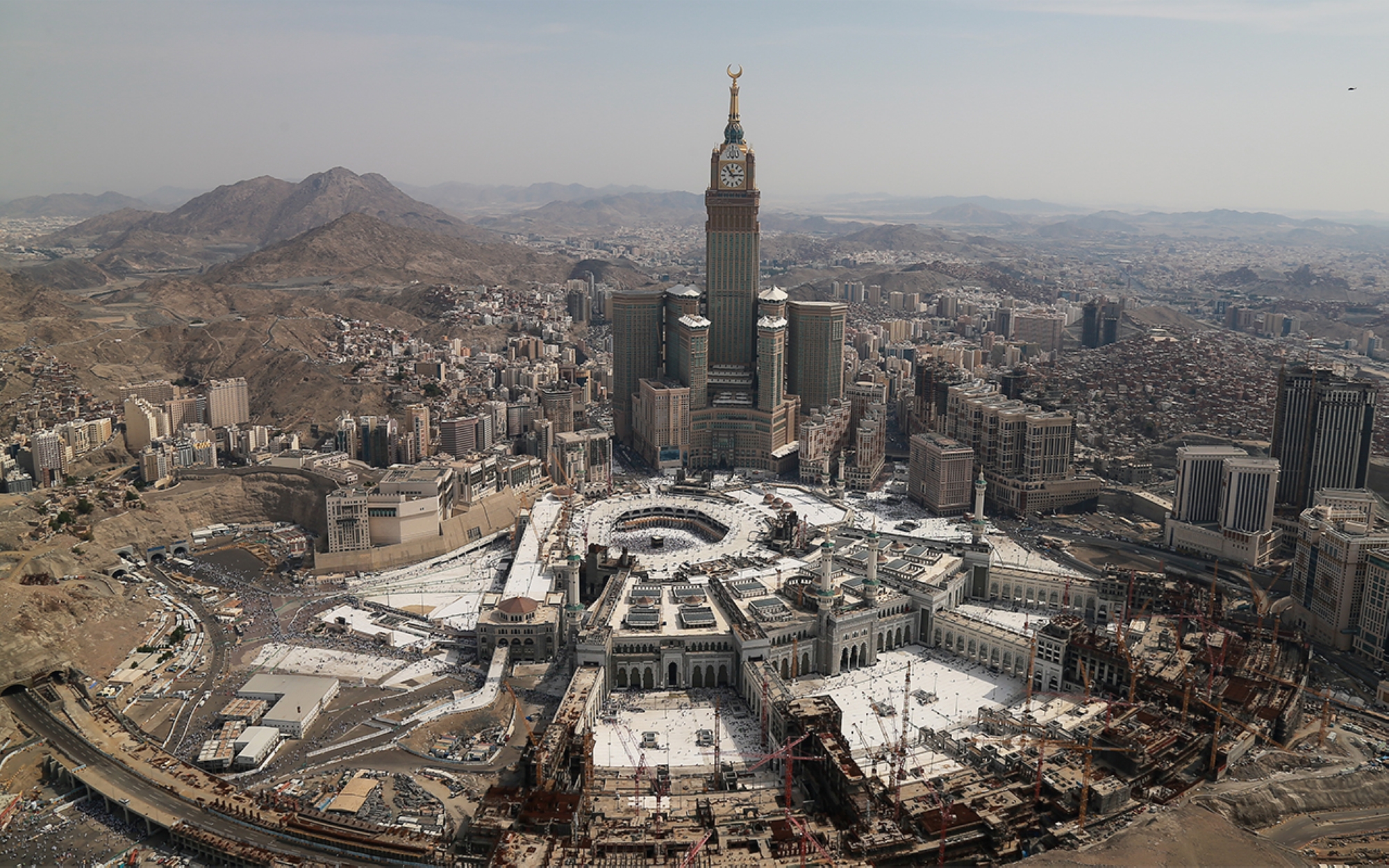
The Kingdom's efforts in caring for the Grand Mosque
Services in the Saudi Era
The Grand Mosque offers seventy-seven services to visitors, including an electronic navigation system to identify entities and facilities, phone charging for visitors and Umrah performers, sermon translation, Braille Qurans for people with visual impairments, electric carts for the elderly, guides to assist worshipers with their inquiries, designated sites for lost people, lost and found offices, health centers, hospital for visitors and Umrah performers.
Expansions in the Saudi Era
The greatest in history, the Saudi expansion of the Grand Mosque was the onset of the mosque's expansion projects which came to a halt for more than ten centuries. The Saudi state's interest in the Grand Mosque began with the directives of the founding King Abdulaziz Bin Abdulrahman Al Saud in 1925, with the expansion of the Grand Mosque. It continued in the reign of his sons, the kings, in three major expansions, which came as follows:
The First Saudi Expansion
During the reign of King Abdulaziz Al Saud
Upon assuming power and entering Makkah al-Mukarramah in 1925, King Abdulaziz Al Saud showed great care for the Grand Mosque. He ordered the complete renovation of the Mosque in 1926, including the full renovation of the entire mosque and the marbling of the pillars. In 1927, he ordered the installation of canopies in the courtyard of the mosque to provide shade for worshipers from the sun. In 1928, he ordered the repair of Maqam Ibrahim, Zamzam Dome, and the base of al-Kaaba. In the same year, he ordered the construction of sturdy fixed canopies along the edge of the Mataf courtyard, made of Javanese wood and covered with thick white fabric. Fixed canopies were also added at the ends of the courtyard, attached to the corridors, to be spread and folded as needed. He also ordered the establishment of the first factory for the covering of al-Kaaba al-Musharrafa. Between 1927 and 1928, the pathway of the Masa'a was paved with square flintstone, and built with Nurah stones. This was the first time this road had ever been paved. He also ordered the removal of the old stalls that had narrowed the Masa'a, and the construction of two pathways for Zamzam Water, along with the renovation of the old pathway. In 1935, he ordered the repair of the carpeted area around the Mataf, the repair of the corridors' floors, the renovation and cladding of the entire mosque, the renewal of colors, and the removal of anything damaged. The old pebbles were also removed and replaced with new ones. In 1947, he ordered the artistic and precise renovation of the ceiling of the Masa'a. The canopy of the ceiling extended the length of the Masa'a from Safa to Marwa, except for eight m opposite the door of Ali (may Allah be pleased with him), which was left uncovered for aesthetic reasons. The entire width of the ceiling was twenty and a half m. He also ordered the creation of a new door for al-Kaaba covered with pure silver sheets, engraved with Quranic verses in gold. Additionally, the hinges of al-Kaaba's door were replaced with pure silver, plated with gold. In 1951, he ordered the complete cladding of the facades facing the Grand Mosque and its courtyards.
During the reign of King Saud Bin Abdulaziz
The expansions and improvements continued during the reign of King Saud Bin Abdulaziz. He ordered the opening of a street behind Safa and the diversion of people and cars from Masa'a street. In 1954, he ordered the installation of a pump to raise Zamzam Water, and he established a building for Zamzam Water supply in front of the Zamzam Well in the following year. In 1956, he ordered the replacement of the six candlesticks in the Hijr of Ismail (PBUH) with five copper candlesticks that are lit by electricity, and he also ordered the paving of the Mataf floor with cement. On October 21, 1955, King Saud delivered his historic speech announcing the start of the expansion of the Grand Mosque, which was ordered by his father, King Abdulaziz. The project began by expropriating the properties located in the expansion area after estimating their prices and compensating their owners. This expansion included the construction of three floors: basements, ground floor, and first floor, with the construction of the Mataf with its two floors, and the expansion of the Mataf, so that the Zamzam Well is in the basement. Then, Zamzam basement was equipped with water taps and a used water channel. The expansion also included the removal of buildings inside the Grand Mosque that were constricting the worshipers and pilgrims in the Mataf courtyard, such as the Zamzam Umbrella, the Bani Shaybah Gate, and the Four Shrines. It also included the diversion of the rainwater stream between Mount Safa and the Ottoman building. It also introduced squares, streets, parking for cars, water facilities, and places for ablution near the Grand Mosque in all directions according to the latest system known at that time. In 1956, he ordered the construction of a silver escalator engraved with gold for al-Kaaba al-Musharrafa. He also ordered the restoration of al-Kaaba al-Musharrafa, and the replacement of its old upper roof with a new roof, while keeping the lower roof after its restoration. This was in 1957.
During the reign of King Faisal Bin Abdulaziz
King Faisal Bin Abdulaziz completed the expansion of the Grand Mosque that began in the reign of his brother, King Saud, which was ordered by their father, King Abdulaziz. He placed Maqam Ibrahim in a crystal case in 1967 and removed the building standing on it to expand the space for Tawaf performers. In 1971, he ordered the construction of a building for the Library of the Grand Mosque. In the following year, he ordered the construction of al-Kaaba's Kiswah factory in its new location in Umm al-Jud, and the expansion of its work.
During the reign of King Khalid Bin Abdulaziz
In 1976, King Khalid Bin Abdulaziz completed the remaining construction and expansion of the Grand Mosque. He finalized the expansion project that was initiated by King Abdulaziz, started by King Saud, and completed by King Faisal. The Kiswa factory was also inaugurated after its completion in 1977. During King Khalid's reign, one of his accomplishments was the expansion of the Mataf in its current form in 1978. Its floor was paved with heat-resistant marble imported from Greece. The expansion of the Mataf included the removal of the Bani Shaybah Gate and the marble minbar from the Mataf. Zamzam Well was also expanded, and its entrance was moved closer to the edge of the old mosque in the direction of the Masa'a. It was divided into sections for men and women. Drinking fountains for cold water were installed, and a glass barrier was placed around the well. In 1979, King Khalid ordered the creation of an exquisite door for al-Kaaba al-Musharrafa, at great expense. Moreover, a door was added for the internal staircase leading to the roof of al-Kaaba. In 1980, a comprehensive cleaning of the Zamzam Well was carried out after the first exploratory operation of the well.
Accordingly, The First Saudi Expansion passed through four phases:
Phase One (1955-1961) included the construction of the Masa'a with its two floors, and the establishment of a low barrier in the middle of the Masa'a dividing it into two sections for walking between Safa and Marwa. Circular staircases were built for Safa and another for Marwa, and eight doors were installed on the eastern facade of the first floor of the Masa'a, facing the main street, providing access to the Grand Mosque. Two entrances from outside the Grand Mosque and two elevators were also added to the second floor.
Phase Two (1961-1969) includes the construction of the Grand Mosque and the exterior of the new building. This phase also involved the expansion of the Mataf area and the construction of staircases for the Zamzam Well.
Phase Three (1969-1972) witnessed the construction of the minarets, the opening of roads, and the establishment of plazas around the Haram.
Phase Four (1973-1976) involved the renovation of the old Haram, with its four corners, to create the three main gates.
At the end of the first Saudi expansion, the area of the Grand Mosque was 160,168 m, accommodating more than three hundred thousand worshipers. In cases of congestion, it can accommodate more than four hundred thousand worshipers. The mosque now has sixty-four doors distributed on its different sides and seven minarets that highlight the dimensions of the Grand Mosque, with a height of eighty-nine m.
The Second Saudi Expansion
In 1983, King Fahd Bin Abdulaziz ordered the expropriation of properties in the Small Market west of the Grand Mosque and compensated their owners with satisfactory amounts. This was done in preparation for a major expansion of the Grand Mosque. The area of the expropriated properties was thirty thousand m, which were transformed into temporary prayer spaces before commencing construction. In 1986, King Fahd ordered the paving of the First Saudi Expansion with heat-resistant, cold marble, and prepared the surface for use. This area was initially designated for electrical work, and scattered electrical networks on the surface were hindering worshipers. King Fahd directed that they be consolidated into elegant domes, allowing the surface to accommodate up to ninety thousand worshipers, covering an area of 61,000 m. He also ordered the installation of five electric staircases in the Grand Mosque to facilitate movement between its floors. Additionally, five elevated bridges were constructed for entry and exit from the first floor, on the north side. In 1989, King Fahd Bin Abdulaziz laid the foundation stone for the Second Saudi Expansion, located in the western part between the Umrah Gate and King Abdulaziz Gate, known as the Small Market. This expansion included a building consisting of a basement, ground floor, and first floor, designed to harmonize with the general appearance of the First expansion. Fourteen new gates were added, bringing the total number of gates in the Grand Mosque to 112. These gates were made of the finest local wood adorned with polished brass. Moreover, this expansion included the construction of two electric staircase buildings on its north and south sides, as well as two interior staircases. In 1991, large courtyards were established around the Grand Mosque, covering an area of 88,000 m. They were prepared for prayer by paving them with heat-resistant, cold marble, installing lighting, and providing furnishings. The following year, the Safa area on the first floor was expanded by narrowing the opening underneath the Safa dome. Furthermore, in 1996, some buildings around the Marwa area were demolished, and the passageway from Marwa to Masa'a on the first floor was expanded. New doors were added on the ground and first floors for entry and exit from the Marwah side. This increased the area of the zone to 375 m. In 1997, the Raqubah Bridge was constructed, connecting the roof of the Grand Mosque with the Raqubah area on the Marwa side to facilitate entry and exit to the roof of the Grand Mosque. In addition, the passageway adjacent to the Masa'a, used for circumambulation on the first floor during crowded times, was widened from the Safa area to approximately half the Masa'a to nine m in width and seventy m in length. In the same year, the covering of Maqam Ibrahim was renewed, made of brass covered with gold, crystal, and decorated glass. A strong and beautiful cover resistant to heat and breakage was placed on Maqam of Ibrahim.
The Third Saudi Expansion
The third expansion of the Grand Mosque began in the reign of King Abdullah Bin Abdulaziz and continued in the reign of the Custodian of the Two Holy Mosques King Salman Bin Abdulaziz. A number of main projects were initiated within the comprehensive project of the Great Third Saudi Expansion of the Grand Mosque on July 12, 2015. Building surfaces reached 1.47 million m2, where the expansion added an area equaling two thirds compared to the old area of the Grand Mosque. It includes twelve main components, including the main expansion building, the expansion of the Masa'a that started previously, the expansion of the Mataf, the external courtyards, bridges, and platforms, the complex of central service buildings, the service tunnel, the security buildings, a hospital, pedestrian tunnels, transportation stations, bridges leading to the Grand Mosque, the first ring road surrounding the Grand Mosque area, and the infrastructure including electricity stations and water tanks.
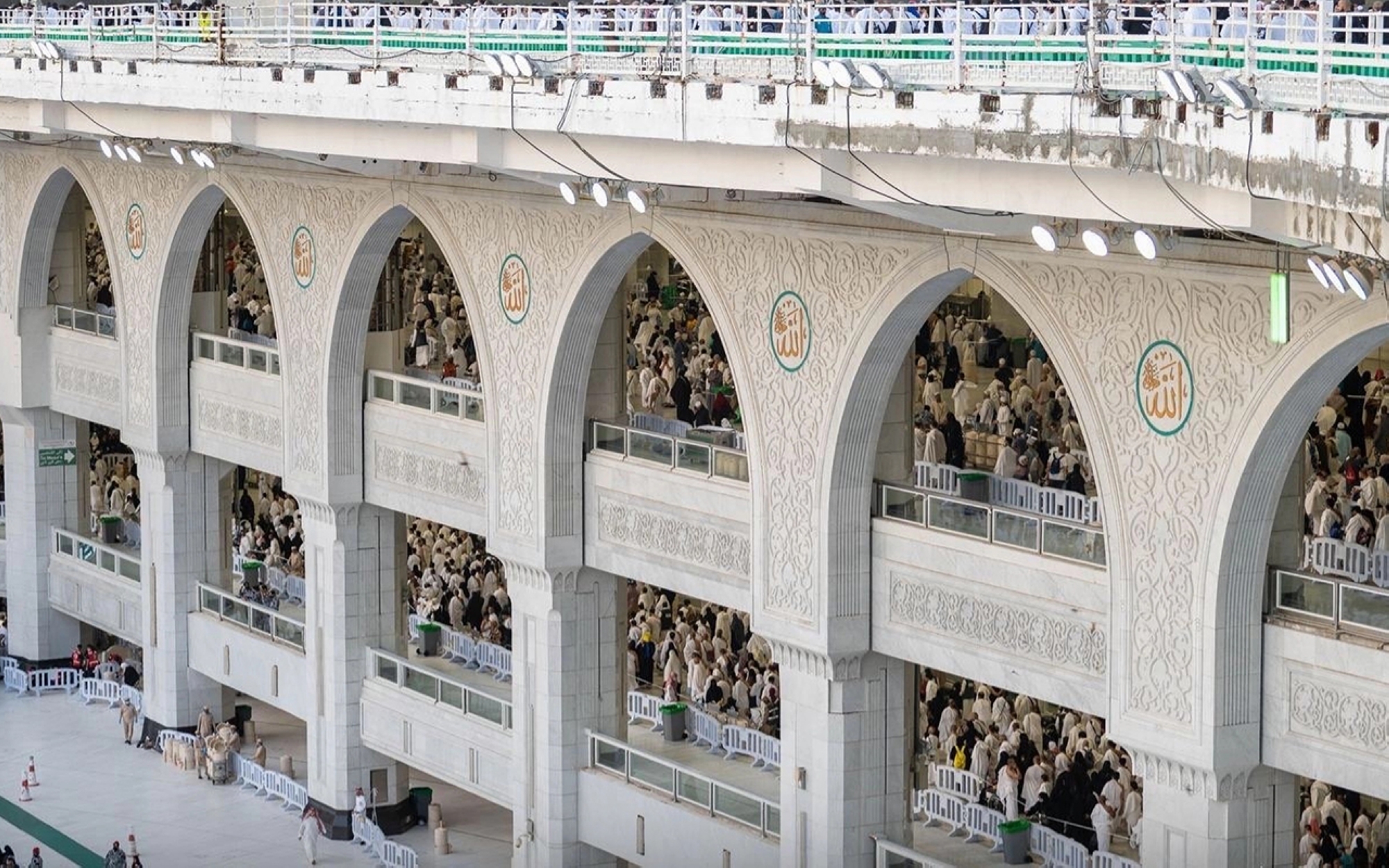
The Saudi Colonnade (Ruwaq)
In Arabic, the word Ruwaq means the space which surrounds something. In Islamic architecture, a colonnade is a space or passageway located between two columns. It contains vertical or parallel arches to the Qibla wall, and it also contains rows of columns. These arches may be intersecting, meaning that they are oriented parallel and perpendicular to the Qibla. The Abbasid colonnade surrounds al-Kaaba al-Musharrafa, and the Saudi Colonnade surrounds the Abbasid colonnade, which was built by al-Mahdi between 778 and 785. It remained standing and represented the building of the Grand Mosque for nearly 1,200 years, during which time some renovations and refurbishments were carried out on the buildings of the Grand Mosque, but the elements of the mosque, its materials, and its area remained the same and did not change. Construction of the Saudi Colonnade began in the reign of King Saud in 1955. In a historic statement, King Saud announced the fulfillment of King Abdulaziz's wish to begin the expansion of the Grand Mosque. Construction of the colonnade continued during the reigns of King Saud, King Faisal, and King Khalid between 1955/1976. Development of the colonnade continued later.
The Saudi Colonnade consists of four floors: the courtyard floor, the ground floor, the first floor, and the mezzanine. It extends from the west side when King Fahd Bin Abdulaziz ordered a new addition to the Saudi Colonnade. The number of columns in this expansion was about 1,500 columns covered with white marble, in addition to several domes on the surface of the arcades. In the reign of King Fahd Bin Abdulaziz, the area of the Grand Mosque became about 365,000 m, and the capacity was about one million worshipers. The Saudi Colonnade included a new gate after this extension, which is King Fahd Gate. The area of the Saudi Colonnade extended from the north side, with a new addition that began in the reign of King Abdullah Bin Abdulaziz and was completed in the reign of King Salman Bin Abdulaziz. The area of the Grand Mosque became about 1.5 million m, with a capacity of about three million worshipers. It included a large number of columns and a gate named King Abdullah Bin Abdulaziz Gate. Over the past years, the kings of the Kingdom have completed the construction of the Saudi Colonnade, which has turned the area of the Grand Mosque from about 12,000 m to about 1.47 million m, and the capacity has increased many times over what it was before.
King Abdulaziz Complex for Kiswa
The first to order the establishment of a dedicated workshop for crafting the Kiswa of al-Kaaba al-Musharrafa was the founder of the Kingdom, King Abdulaziz Al Saud, in 1927. It is now known as King Abdulaziz Complex for the Kiswa of the Kaaba, which falls under the General Authority for the Affairs of the Grand Mosque and the Prophet's Mosque. The Kiswa is woven with threads of silk, gold, and silver, and the largest section is renewed and delivered to the senior Sudanah of the Grand Mosque on the first day of each Hijri year. Its cost exceeded approximately SAR20 million in 2022. The cloth weighs 850 kg, divided into forty-seven pieces of fabric, each with a width of ninety-eight cm and a height of fourteen m. The Kiswa factory comprises various technical and operational departments, employing two hundred craftsmen and technicians. Among its sections is the dyeing department, where the initial stages of Kiswa production begin, using the finest natural silk in the world. There's also the automated weaving section, where Quranic verses and phrases are woven. The laboratory section ensures that the threads meet the required standard specifications in terms of tensile strength and resistance to weathering. Other departments include the belt and embroidery section, the Kiswah sewing section, and finally, the unit for the care of the Kiswah of al-Kaaba al-Musharrafa. The first Saudi cover for al-Kaaba al-Musharrafa was produced at the King Abdulaziz Complex in 1927. During the reign of King Abdullah Bin Abdulaziz, the electronic systems, electrical devices, and mechanical equipment at the Kiswa factory were updated and replaced to align with modernized systems. This step marked an advanced developmental leap in the field of manufacturing the cover of al-Kaaba al-Musharrafa. In 2018, the Custodian of the Two Holy Mosques, King Salman Bin Abdulaziz, issued approval to change the name of the factory for crafting the Kiswa of al-Kaaba al-Musharrafa to the King Abdulaziz Complex for Kiswah of al-Kaaba al-Musharrafa.
Related quizzes


